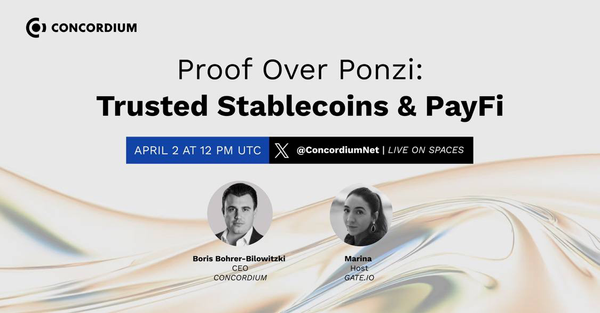The L1 Redefining Stablecoins & PayFi

Summary of Key Insights from the Brave New Coin Podcast with Concordium CEO Boris Bohrer-Bilowitzki
Watch the full episode on YouTube
In this wide-ranging Brave New Coin podcast episode, Boris Bohrer-Bilowitzki—CEO of Concordium—shares his journey from hedge funds to blockchain and explains why Web3 needs a reset. From identity and regulation to programmable money and protocol-level tokens (PLTs), Boris lays out a bold vision for real-world blockchain adoption.
This summary distills the most important insights and takeaways from the conversation—ideal for revisiting or sharing.
Table of Contents (Jump to Sections)
- Q1 Can you briefly share your personal and professional background leading up to becoming CEO at Concordium?
- Q2: Why are you disillusioned with Web3, and what's holding it back?
- Q3: What's the difference between privacy and anonymity?
- Q4: Concordium's identity layer and real-world use cases
- Q5: Stablecoin issuers and why it matters
- Q6: Smart contracts, programmable money & risk
- Q7: Protocol-Level Tokens (PLTs) and their impact
- Q8: How to learn more and get involved
- Q9: Boris' crypto hot takes
- Q10: Final shoutout + how to follow Concordium
Q1 Can you briefly share your personal and professional background leading up to becoming CEO at Concordium?
Finance Background:
- Extensive experience in finance, specifically hedge funds and asset management.
Transition to FinTech:
- Initially moved to London intending to open a restaurant, but that plan didn’t materialize.
- Met Dimitri, a future business partner, and co-founded Copper in early 2018.
Building Copper:
- Copper became one of the world’s leading custodians and prime service providers for institutions in crypto.
- Grew significantly into a multi-billion-dollar business catering exclusively to institutional clients.
Leaving Copper and Joining Concordium:
- Felt it was time to hand over Copper to the next leadership team during its growth phase.
- Left Copper around mid-2023.
- Concordium had been a client of Copper; Boris was already familiar and fascinated with the project.
Why Concordium:
- Developed a friendship with Concordium’s founder, Lars Christensen (co-founder and former 20-year CEO of Saxo Bank).
- Particularly intrigued by Concordium’s unique identity layer.
- Expressed disappointment with the overall direction and development of the crypto/Web3 space over recent years.
- Saw Concordium as uniquely positioned to address these issues, though initially ahead of its time.
New Direction and Strategy at Concordium:
- Joined Concordium and introduced a new management team at the beginning of 2024.
- Implemented a fresh strategy and focus, already showing promising results.
Comments:
Visit: https://t.me/c/1659427635/28420
Q2 Why are you disillusioned with Web3, and what's holding it back?
Web3’s Original Purpose:
- Inspired by Satoshi’s white paper—global digital money transfer.
- Boris revisits it regularly; believes the space lost that focus.
Shift to Hype Cycles:
- ICO boom prioritized fundraising.
- DeFi, NFTs (e.g., punks, apes) brought innovation, but also distraction.
- Space never fully moved beyond speculation.
Missing Infrastructure:
- No built-in identity layer.
- In real-world finance, identity is essential—you can’t just open a bank account anonymously.
Regulatory Reality:
- Crypto ethos resists regulation, but that’s unsustainable.
- Security, compliance, and user protections are necessary for adoption.
Unfulfilled Promises:
- Cross-border payments still slow, expensive, and filled with intermediaries.
- Blockchain hasn’t yet delivered on making them seamless.
The Way Forward:
- Privacy-preserving identity is the key.
- Only path to real, scalable financial interaction in Web3.
Comments:
Visit: https://t.me/c/1659427635/28421
Q3 What's the difference between privacy and anonymity in blockchain, and how should it be approached?
Privacy ≠ Anonymity:
- Key distinction: privacy can be regulated; anonymity can’t.
- Pure privacy chains don’t fit global legal frameworks.
Concordium’s Approach:
- Built-in identity layer aligns with regulation.
- Concordium is the only one doing it “properly.”
Innovation Reframed:
- True innovation isn’t creating problems to solve later.
- It’s applying existing tech to real-world issues.
Path to Adoption:
- Adoption comes from solving real, existing problems.
- Concordium is uniquely positioned for this next phase.
Comments:
Visit: https://t.me/c/1659427635/28422
Q4 Can you walk us through Concordium's identity layer - how it works, the tech behind it, and real-world use cases?
How the Identity Layer Works:
- Identity not stored on chain—no passport scans floating on blockchain.
- When setting up a wallet, user completes KYC via third-party ID providers (like in traditional onboarding).
- Result: an identity object linked to the wallet (e.g. name, DOB, etc.—but not the document itself).
- Enables privacy-preserving compliance using zero-knowledge proofs (ZKPs).
Role of Zero-Knowledge Proofs:
- Sensitive data never revealed (e.g., passport number, address).
- ZKP confirms user meets criteria (e.g., geographic location, age, accreditation) without exposing the data.
- Enables wallet-to-wallet compliance checks—e.g. for geofencing or securities eligibility.
Use Case: Tokenized Money Market Funds
- These are securities under U.S. law.
- Legal access requires location-based restrictions (e.g., only U.S. investors).
- Concordium enables ZKP-based geofencing—ensures eligibility without revealing personal data.
Use Case: Stablecoins in Emerging Markets
- Example: Non-yield-bearing stablecoins (e.g. USDT, USDC) used in South America for daily purchases.
- Today’s stablecoins mostly used for trading or DeFi—not real payments.
- With Concordium: identity and programmable money enable true consumer use (e.g., Amazon, Deliveroo).
- This bridges gap between stablecoins and real-world services.
Bigger Picture:
- Identity layer + ZKPs unlocks real-world utility and regulatory compliance.
- Concordium focuses on solving existing problems, not creating new ones.
- Core mission ties back to Satoshi’s original vision: programmable, borderless money with trust and privacy.
Comments:
Visit: https://t.me/c/1659427635/28423
Q5 Who can issue stablecoins using Concordium's tech stack, and why is this important?
Types of Issuers:
- Institutions (e.g., financial firms like World Liberty Financial).
- Organizations (e.g., e-commerce, payment platforms like PayPal).
Geopolitical Angle:
- Stablecoins tied to USD could help counter de-dollarization.
- USD remains the global reserve currency—keeping it central is strategic.
Open Issuance Model:
- Anyone with a valid use case can issue a tokens on Concordium.
- From crypto punk tokens to “usable smart money”—flexibility is key.
Core Message:
- Payments drive the economy—stablecoins are a natural evolution.
- Concordium enables compliant, customizable issuance for all actors.
Comments:
Visit: https://t.me/c/1659427635/28424
Q6 What's the difference with Concordium's approach to smart contracts and programmable money, and how does it address risks?
Smart Contracts = Risky Custodians:
- Today, smart contracts often act as custodians—a major risk.
- Boris calls them “dumb banks”—they shouldn’t hold value.
- Their role should be limited to enforcing conditions, not storing assets.
Security Risks in the Current Model:
- Complex ecosystems (e.g. Ethereum, Tron) = high attack surface.
- Most high-profile hacks target smart contracts, not base-layer blockchains.
Concordium’s Alternative – Protocol-Level Tokens (PLTs):
- PLTs are issued directly on Layer 1, alongside CCD.
- Avoids smart contract complexity and minimizes custodial risk.
- Creates native stablecoins with built-in compliance features.
Benefits of PLTs:
- Safer architecture—fewer exploits than contract-based tokens.
- Enables programmable money at the base layer.
- Examples: geofencing, age verification, source of funds.
- Ideal for sectors like gaming, gambling, social media, etc.
- Preserves user privacy without relying on unregulated privacy coins.
Big Picture:
- Concordium simplifies back to blockchain’s core promise: trust, safety, utility.
- Larger chains may struggle to adapt due to legacy complexity.
Comments:
Visit: https://t.me/c/1659427635/28425
Q7 What are the long-term implications of Protocol-Level Tokens (PLTs) for finance and efficiency?
New Interaction Model:
- PLTs change how we interact with money.
- Q3/Q4 roadmap includes smart locks and multi-locks to expand control.
Example: Trade Finance
- Natural resource deals (e.g., crude oil) = multi-trillion-dollar market.
- Traditional model: funds locked in smart contracts → vulnerable to hacks.
- Concordium model: PLTs sit at base layer, can’t be moved or hacked.
- Smart contract connects to GPS oracle → releases funds every 100m of cargo movement.
Efficiency Gains:
- Funds flow only between defined parties.
- Eliminates need for internal finance functions to manage schedules.
- Suppliers can be paid instantly upon delivery milestones.
Programmable Use Cases:
- E-commerce example: delay payment until delivery (e.g., Amazon order).
- Idle funds could earn yield until service is fulfilled.
Conclusion:
- PLTs enable safer, programmable, real-world finance.
- “Opportunities are endless.”
Comments:
Visit: https://t.me/c/1659427635/28426
Q8 Where can people learn more about Concordium and get involved?
Where to Go:
- Main site: concordium.com — full overview of the protocol and roadmap.
Socials:
- X (Twitter): @ConcordiumNet
- LinkedIn and other standard channels.
What’s There:
- Active updates, product info, roadmap details.
- Clear explanation of Concordium’s mission and technology.
Extra Note (from host):
- Concordium is rooted in Latin—symbolizing harmony, unity, and trust.
Comments:
Visit: https://t.me/c/1659427635/28427
Q9 Let's wrap up with a rapid-fire round - crypto hot takes from Boris.
Bitcoin Maximalist or Multi-Chain?
- Middle, leaning Bitcoin maximalist.
- Thinks most existing chains won’t survive 5–10 years.
- Future winners may not even be known yet.
Strongest Crypto Opinion:
- “Smart contracts are dumb banks.”
10-Year Outlook for Blockchain:
- Blockchain will finally be used in everyday life.
- Key area: payments—from coffee to complex financial transactions.
- Concordium aims to lead in this space.
Example of the Future Already Here:
- Stablecoins used for daily payments in parts of the world.
- Value is based on social agreement—just like shells or rocks once were.
- “Blockchain is here to be used, not understood.”
Favorite Sci-Fi Film or Show:
- Terminator (with a nod to The Matrix).
- Finds it both compelling and a bit frightening in light of current tech trends.
Comments:
Visit: https://t.me/c/1659427635/28429
Q10 Final shoutout - how can people follow Concordium and get involved?
Core Mission:
- Concordium is focused on programmable money and stablecoins issued at protocol level.
- Goal: eliminate smart contracts as custodial tools—build safer, compliant infrastructure.
Expect major announcements in the coming weeks.
Final Note:
- “Smart contracts are dumb banks? Step away!





